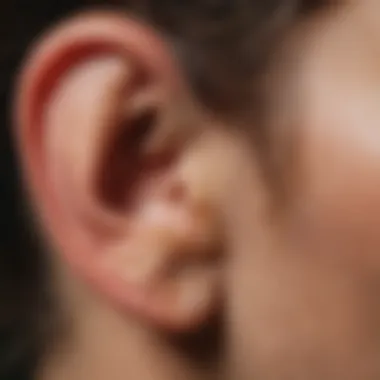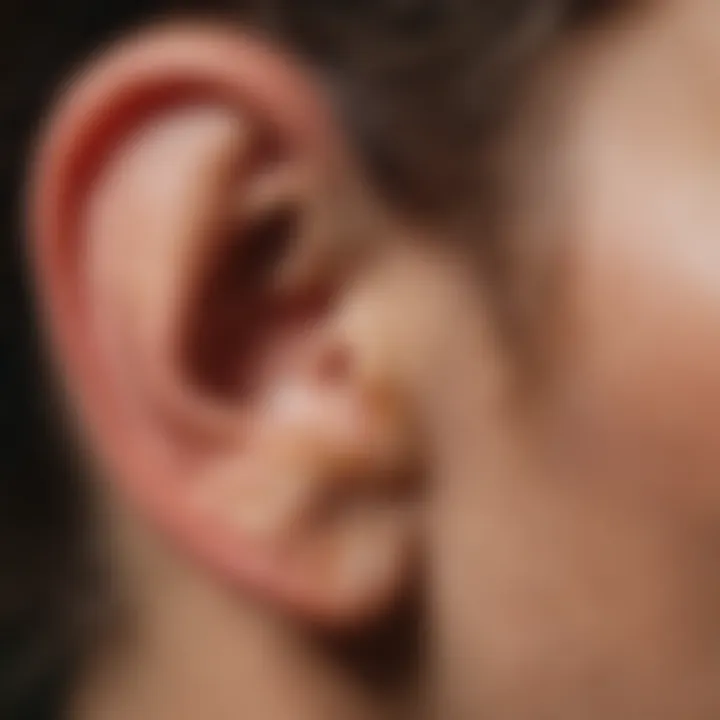Effective Techniques to Remove Water from the Ear


Intro
Water in the ear can be a real nuisance, especially for those who embrace aquatic activities. Whether you're a swimmer, surfer, or just someone who loves a good dip, the feeling of water trapped in the ear can be annoying and, at times, even painful. It can interfere with your enjoyment and lead to an unsettling sensation that lingers long after your time in the water has passed. Fortunately, understanding how to safely remove that water can make all the difference.
This guide will break down various approaches for tackling this common issue, helping you not only to find relief but also to prevent future occurrences. The ear canal is a delicate structure, and knowing how to care for it is essential. We’ll delve into effective techniques and provide insights on ear health that are crucial for any water sports enthusiast or outdoor adventurer.
By the end of this article, you'll have a clearer perspective on how to combat the discomfort of water in your ears while safeguarding your auditory health.
Techniques and Skills
Fundamental Techniques for Beginners
For those who are kinking their toes into the watersports world, it's vital to start with the basics. Learning how to effectively remove water from your ear can set you on the right path and pave the way for a more enjoyable experience.
Some effective and simple methods include:
- Gravity Technique: Tilt your head to the side, ear facing downward. Gently tug on your earlobe to help the water flow out. This approach uses gravity to do a lot of the heavy lifting.
- Jaw Movements: Open and close your mouth as if yawning, which can help create air pressure that pushes the trapped water out of the ear.
- Heat Application: Using a warm compress applied to the ear can help ease discomfort while potentially encouraging water to escape as it dilates the ear canal and allows for better drainage.
Each of these methods is straightforward yet can yield impressive results for those feeling like a fish out of water.
Advanced Skills for Experienced Athletes
For seasoned adventurers, especially those who frequently find themselves in water bodies, mastering the techniques can be beneficial. Here are some advanced skills that might help:
- Ear Drying Methods: Invest in ear drying drops or consider using a specialized ear dryer to blow air into your ear canal. This gadget can be a lifesaver for frequent travelers or water athletes who want to avoid the discomfort altogether.
- Earplugs: Reinforcing preventative measures with quality earplugs designed for water activities can keep water out of your ears, keeping the troublesome sensation at bay.
Safety Considerations
While focusing on techniques, safety should never take a backseat. It’s easy to get caught up in the hustle of enjoying water activities, but it’s crucial to prioritize ear health. Knowing your limits and avoiding overly aggressive cleaning methods, like cotton swabs, ensures you don't push the issue further into discomfort.
"Taking the time to understand the anatomy of your ear can provide insight that ultimately leads to safer practices in your aquatic adventures."
As we navigate through this topic, remember that the expertise gathered from experience, combined with a solid base of knowledge, can lead to healthier habits when dealing with the ears. Proper care is essential for those who love the aquatic realm, ensuring that every dive and splash is met with joy, not discomfort.
Understanding Ear Anatomy and Water Retention
Understanding the relationship between ear anatomy and the phenomenon of water retention is critical for anyone often engaging in aquatic activities. Grasping how our ears are structured aids in identifying how water can become lodged within the ear canal. Recognizing these intricacies not only enhances one's comprehension of this common issue, but also assists in employing effective removal techniques, ensuring that ear health remains intact.
Structure of the Ear
The ear is divided into three primary sections: the outer ear, middle ear, and inner ear, each serving distinct functions while playing a role in how we perceive sound. The outer ear comprises the pinna and the ear canal, which directs sound waves inward.
The ear canal, specifically, has its own quirks—a somewhat lengthy, tubular structure that funnels sounds toward the eardrum. It is lined with skin that produces earwax, which, while often underrated, plays an important role in protecting the ear. The middle ear contains the eardrum and three tiny bones known as the ossicles, while the inner ear houses the structures essential for balance and hearing.
Water can easily slip into this complex arrangement. For instance, when swimming, the natural positioning of the head may allow water to enter the ear canal, and due to its twisty shape, that water can become trapped.
Why Water Gets Trapped
Water retention in the ear happens for a few reasons. The ear canal is not straight; it has bends and turns. Because of this winding structure, water can create what feels like a pocket, making it difficult for the liquid to drain out naturally. Plus, our everyday activities such as swimming, bathing, or even taking a shower can contribute to unwanted moisture seeping into the canals.
When water does get lodged, it can cause various discomforts, ranging from mild irritation to more serious complications if not addressed. Furthermore, certain changes in pressure, like during air travel or diving, might exacerbate this issue, leading to feelings of fullness or even muffled hearing.
Common Causes of Water in the Ear
Understanding the common causes of water becoming trapped in the ear is essential for effectively preventing and addressing the issue. Water retention in the ear can lead to discomfort, temporary hearing loss, and even infections if not managed properly. By recognizing the specific situations that contribute to this problem, individuals can take proactive steps to mitigate their chances of experiencing these symptoms.
Swimming and Surfing
For many, splashing around in the water during a swim or riding the waves while surfing is a thrilling adventure. However, these enjoyable activities come with their own set of challenges. When you’re in water, especially in a dynamic environment like the ocean, it’s easy for water to flow into the ear canal. The anatomy of the ear is such that its curves and recesses can trap water, making it difficult for it to escape, particularly in people with narrower ear canals.
Being aware of this can help you adopt measures to minimize water entry. Things like using earplugs designed for swimming or specialized swim caps can be a simple yet effective deterrent against water taking an unwanted holiday in your ears. A good swim may feel invigorating, but it’s wise to equip oneself against the associated risks of discomfort and possible infection that can result from careless water exposure.
Showering and Bathing


Daily hygiene routines like showering or taking a bath might seem harmless. Yet, they also present a significant risk for water becoming trapped in the ear canal. The flow of water, combined with movements like tilting your head under a showerhead, can cause water to seep in. This is particularly likely when washing long hair or rinsing your face, as water can easily roll down towards the ears.
To prevent this, consider using a soft washcloth to block the ear openings while you rinse off. It might feel a little strange, but keeping cotton swabs handy can help clear out any excess moisture after you finish bathing.
Diving Incidents
Diving poses a unique risk for water retention due to the high-pressure environment beneath the surface. When you dive, water pressure can force water into the ears more easily than during surface-level activities. Even the most experienced divers can sometimes find that they emerge from the water with trapped water in their ears, leading to frustration and discomfort.
Adhering to proper equalization techniques during descents and ascents is crucial in preventing this. Moreover, safety protocols such as ensuring that ear canals are checked and dry before diving can mitigate risks significantly. A small bit of preparation can lead to a much more enjoyable underwater experience.
"Preparation often sets the stage for an enjoyable adventure, or at least one marked by fewer annoyances."
Being aware of these common causes can empower you to take steps to shield your ears from water, reducing the risk of discomfort and keeping your ear health in optimal shape.
Symptoms of Water in the Ear
Understanding the symptoms of water trapped in the ear canal is crucial for individuals, particularly for water sports enthusiasts, who frequently find themselves in situations that can lead to water retention. Identifying these symptoms early on can make a significant difference in managing discomfort and preventing potential complications. The aspect of recognizing the symptoms is not just about addressing immediate discomfort but also about fostering awareness to avoid future incidents.
Hearing Impairment
One of the first signs that water is lingering in the ear is a noticeable change in hearing. You might experience muffled sounds or a sense that your ears are clogged, as if you are trying to listen through a thick blanket. This temporary hearing impairment can be frustrating and may interfere with communication, especially in a noisy environment, such as a poolside or at the beach.
Water trapped in the ear can disrupt the normal transmission of sound waves. The fluid creates a barrier that alters how sound travels, leading to a perception of fullness in the ear. Addressing this symptom promptly not only minimizes discomfort but also helps in maintaining clear hearing, allowing outdoor adventurers to fully enjoy their experiences.
Discomfort and Fullness
Alongside impaired hearing, the sensation of discomfort and fullness in the ear can be quite bothersome. This symptom is often described as pressure building up inside the ear canal, akin to the feeling one experiences during a flight when the cabin pressure changes. It may cause annoyance and difficulty concentrating on activities, detracting from the joys of swimming or surfing.
The sensation can vary from mild irritation to severe discomfort, depending on how long the water has been sitting in the ear. Left untreated, this feeling can lead to restlessness and even pain. Practicing the proper techniques for removing water can greatly alleviate this fullness, restoring comfort and allowing individuals to return to their aquatic activities without hindrance.
Potential Infection Signs
Ignoring the symptoms of water in the ear can sometimes lead to more serious issues, such as infections. If water remains trapped for too long, it can create a warm, dark environment that is ideal for bacteria and fungus to thrive. Symptoms indicating a potential infection include increased pain, discharge from the ear, and fever.
If you notice any of these warning signs, it is essential to seek professional help. Ear infections can become serious and may lead to long-term complications if not addressed swiftly. Maintaining awareness of these potential symptoms can mean the difference between a quick recovery and ongoing health issues. Regular follow-ups at Wikipedia or Britannica can provide additional guidance on awareness and prevention of ear infections.
"Ignoring water in the ear isn't simply inconvenient; it can open the door to potential infections that may create lasting problems."
Methods for Removing Water from the Ear
Understanding how to effectively remove water from the ear is crucial, especially for those who frequently engage in water activities. Water trapped in the ear canal can cause discomfort and even lead to infections if not addressed promptly. Each technique used for removal offers unique benefits and considerations, providing a range of options tailored to different situations. By mastering these methods, individuals can ensure not just relief but also maintain their ear health.
Gravity and Head Positioning
One of the simplest and most natural techniques is using gravity and head positioning. You can start by tilting your head toward the affected side, creating an angle that facilitates the water to flow out due to gravity. This method relies on the natural shape of the ear canal and may be especially effective if the water is not stuck deep inside.
Here’s how to perform this method:
- Tilt your head: Lean your head to the side, keeping it parallel to the ground. This angle helps the water flow toward the ear opening.
- Jumping or shaking your head: Sometimes, gently shaking or even hopping on one foot can create enough movement to help dislodge the water.
While this method is generally safe, individuals with discomfort should refrain from excessive movement that could lead to further irritation.
Using a Warm Compress
Applying a warm compress to the ear can be helpful in loosening water trapped inside. The warmth can encourage the ear wax to soften or help the muscles in the ear canal to relax, allowing the water to drain more freely. Here’s a brief rundown:
- Prepare the compress: Soak a clean cloth or towel in warm water, wring it out, and ensure it's comfortably warm—not boiling.
- Application: Place the warm compress over the ear for about 20 minutes. The gentle heat can also soothe any underlying discomfort from having water trapped.
It's worth noting to avoid extreme temperatures as they may damage sensitive ear tissues.
The Valsalva Maneuver
The Valsalva maneuver is often recommended for clearing fluid from the middle ear by equalizing pressure. It might sound complicated, but it’s rather simple: you pinch your nose, close your mouth, and gently blow. This creates pressure that can push the water out. Here’s how to do it:
- Close your mouth and pinch your nose: Make sure you're sealing those two off so the air can't escape.
- Blow gently: Take a small breath and blow gently. You should hear a slight pop, which indicates that the pressure has adjusted.


However, be cautious—blowing too hard may cause damage to the inner ear, so it’s always better to proceed with gentleness.
Ear Drying Drops
Ear drying drops specifically designed to eliminate moisture can be a convenient option. These typically contain isopropyl alcohol or other drying agents. They work by evaporating the trapped water and can prevent potential infections. When considering this method, remember to:
- Follow instructions: Always refer to the product label and use as directed for best results.
- Consult a professional: If you have a history of ear issues, getting a recommendation from a healthcare expert could be smart before trying anything.
Using ear drying drops can be beneficial, especially after swimming or bathing, as they often act quickly to relieve discomfort.
Remember, the methods mentioned here are effective and safe when applied correctly. However, if water remains trapped and symptoms persist, seeking medical advice ensures you receive the best care.
When to Seek Professional Help
Determining the right course of action when dealing with water trapped in the ear can be tricky at times. While many methods exist for self-removal, there are specific situations where seeking professional help becomes crucial. Ignoring the signs can lead to more serious complications down the line, especially for those who are frequently involved in water-centric activities like swimming or diving.
Symptoms Indicating Infection
One of the first red flags that should trigger an appointment with a healthcare provider is the presence of specific symptoms pointing towards an infection. Noticing any of the following indicators is essential:
- Increased Pain: If discomfort transitions into sharp or throbbing pain, it might suggest that infection is setting in.
- Fluid Discharge: Any noticeable discharge from the ear, particularly if it is cloudy or foul-smelling, is a cause for concern.
- Fever: A rise in body temperature can signify that the body is fighting an infection.
- Persistent Itching: Prolonged itching that does not subside may indicate an underlying problem such as a fungal infection.
"An ear infection can escalate rapidly, thus it’s always best to err on the side of caution and consult a professional if you notice unusual symptoms."
If you encounter one or more of these symptoms, it’s vital to reach out to a medical professional. Getting timely advice can prevent more significant issues that can arise from untreated infections.
Persistent Discomfort
Persistent discomfort in the ear after trying various home remedies should raise a flag. If water remains trapped despite efforts or if you feel a constant sensation of fullness, it’s time to consult someone with medical expertise. Consider this:
- Unresolved Sensations: If regular techniques like gravity positioning or warm compresses fail, this could indicate a blockage that requires professional evaluation.
- Difficulty Hearing: An inability to hear properly or a feeling of pressure that doesn’t go away could also warrant attention. It may signal that the ear canal is more than just obstructed.
- Balance Issues: If persistent discomfort is accompanied by dizziness or balance problems, the underlying cause might be serious enough to seek immediate help.
In these situations, a healthcare provider can properly assess and advise on the next best steps, which might include prescribing medication or, in more severe cases, manual irrigation of the ear.
Overall, staying tuned into your body’s signals is key. Knowing when to seek professional assistance can spare you from complications and help maintain ear health in the long run.
Preventative Measures to Avoid Water Retention
Water retention in the ear can be quite bothersome, leading to discomfort and potential health issues if not addressed correctly. In this section, we will delve into effective preventative measures that can help maintain ear health and avoid unnecessary complications related to trapped water. Understanding these methods not only enhances comfort but also protects against conditions that might arise from prolonged exposure to moisture.
Using Earplugs or Swim Caps
For those who enjoy water activities, the use of earplugs or swim caps can make a significant difference. These tools act as physical barriers, minimizing the entry of water into the ear canal. Earplugs designed specifically for swimming can create a tight seal, allowing swimmers to fully immerse themselves without worry. Similarly, swim caps reduce water entry, but they can also help keep the ears dry, especially in water-intensive situations like surfing or water aerobics. Whenever engaging in recreational activities, simply slipping in some earplugs or donning a cap can save a whole lot of discomfort later. It’s an action that takes little effort yet has considerable payoff.
Proper Drying Techniques After Swimming
Understanding how to properly dry your ears after swimming can further safeguard against water retention. It may sound straightforward, but giving attention to this process is crucial. After your swim, consider tilting your head to one side, allowing gravity to do its part. You can gently tug on your earlobe to help water escape. Additionally, using a soft towel to carefully dab around the outer ear can absorb excess moisture without pushing it deeper.
Sometimes, (though rarely advised) a hair dryer set at low speed and held at a safe distance can also help evaporate trapped water if you're feeling particularly cautious. Just remember to maintain a safe distance to avoid any heat-related damage.
Educating on Safe Practices
Knowledge is power, especially when it comes to preventing water from becoming a nuisance in your ears. Educating both yourself and others on safe water practices can go a long way. This includes knowing when to avoid risky situations, such as diving headfirst in shallow water or immersing oneself in murky lakes where visibility and conditions may vary.
Informing young swimmers about the importance of lifting their heads instead of submerging them entirely can drastically lower the chances of water trapping in the ears. Regularly discussing these practices within a community of outdoor adventurers promotes awareness and helps everyone make wiser decisions in and around water.
Staying informed about preventative measures not only enhances individual safety but reinforces a culture of awareness within the entire water sports community.
Implementing these preventative steps can notably reduce the chances of water retention in the ear. As with anything, fostering habits that encourage ear health will reap benefits not just today, but for many swims to come.
Implications of Ignoring Water in the Ear
The presence of water in the ear can often feel like a minor inconvenience, a mere annoyance that can be easily overlooked. However, this seemingly trivial situation carries a weighty significance—ignoring the retention of water can lead to serious consequences. Understanding the implications of leaving water trapped in the ear not only sheds light on potential health issues but also emphasizes the need for immediate action and proper care.
Potential Hearing Loss


One of the most alarming risks linked to water remaining in the ear is potential hearing loss. Water can create a barrier that disrupts sound waves, leading to muffled hearing or even temporary hearing loss.
- How Does This Happen? When water fills the ear canal, it can form a sort of dam, blocking sound signals from reaching the eardrum effectively. The longer the water stays trapped, the greater the risk becomes.
- Temporary vs. Permanent Loss: While many might experience only temporary impairments, persistent blockage can cause more severe issues. Chronic exposure might lead to alterations in ear function, making it vital to address water retention quickly.
Ignoring this symptom can have cascading effects on one’s overall auditory health. As your ears get accustomed to this dysfunction, the wear and tear could escalate, leading not just to hearing problems, but to a reduced quality of life, especially for those who rely heavily on their auditory senses, such as musicians or teachers.
"A stitch in time saves nine." Addressing water retention early can prevent greater complications, including lasting damage.
Risk of Ear Infections
Another critical implication of neglecting water in the ear is the significant risk of ear infections. The ear canal provides a perfect breeding ground for bacteria and pathogens when moisture is trapped inside.
- Why Does This Happen? The conditions created by stagnant water can lead to otitis externa, commonly known as swimmer's ear. This condition arises as the moisture serves as a catalyst for germs and fungi.
- Symptoms to Watch For: If formal treatment isn’t sought, you might experience itching, redness, swelling, and even excruciating pain. In severe cases, this can even result in discharge or fever.
While some might argue that ear infections are not debilitating, the reality is they can lead to painful experiences and even complications that affect hearing and balance. Addressing the moisture promptly can not only avert immediate discomfort but also maintain overall ear health.
Being aware of these implications underlines the importance of taking action when water gets trapped. It’s not just about comfort; it’s about safeguarding your auditory health and preventing circumstances that could derail your daily activities.
Alternative Approaches to Consider
Considering the best methods for removing water from the ear, it’s essential to examine various alternative approaches. Sometimes, conventional methods may not work for everyone or might be difficult to follow in certain situations. This could be particularly relevant for water sports enthusiasts or those engaged in outdoor activities, where prompt and effective solutions are necessary. Here, we explore home remedies and over-the-counter solutions, shedding light on their significance, benefits, and key considerations that come with each of these approaches.
Home Remedies
Home remedies often come to the rescue when facing the annoyance of water trapped in the ears. They tend to be accessible, affordable, and can be found in most households. Here are some of the popular home methods:
- Tilt and Drain: Leaning your head to the side may allow gravity to assist in drainage.
- Vinegar and Rubbing Alcohol: A mix of one part white vinegar and one part alcohol can help restore balance in pH levels while aiding in drying out the ear.
- Heat Compress: Applying a warm towel against the ear can help ease discomfort and encourage water to evaporate, relieving that irritating sensation.
It's important to note, home remedies can provide an immediate sense of relief, they should be approached with caution. Not every method works for everyone, and techniques that seem beneficial could sometimes lead to further irritation. If you're trying a home remedy, pay attention to how your body responds.
"While many swear by these methods, what works for one's neighbor might not work for you. Always stay attuned to your ear's signals."
Over-the-Counter Solutions
In addition to home remedies, there are over-the-counter solutions available that can be very effective. These products often offer an immediate option for those seeking relief without consulting a medical professional. Here’s what to consider:
- Ear Drying Drops: These can effectively help to evaporate water in the ears and most often can be found in your local pharmacy.
- Hydrogen Peroxide: Some formulations aim to assist in cleaning the ear canal and preventing moisture retention, which can be handy post-swim. However, it should be used with care.
- Alcohol-Ether Mixtures: Commonly used as drying agents, these solutions are designed to speed up the evaporation process.
While these options can be effective, it’s important to read the labels carefully. Not all solutions are suitable for everyone, especially if you have existing ear issues or sensitivities. Many over-the-counter remedies may help ease your symptoms but do not replace professional advice.
In summary, whether you lean toward home remedies or opt for convenience with over-the-counter solutions, each approach comes with distinct benefits and considerations. Always keep in mind that what may bring relief for one person might not yield the same results for another. When it comes to ear health, individual experience often dictates the best course of action.
Understanding the Role of Ear Wax
Ear wax, often dismissed as a mere nuisance, plays a crucial role in ear health, especially when it comes to the presence of water in the ear canal. This natural substance serves multiple functions that are particularly relevant for individuals who frequently find themselves in aquatic environments, such as swimmers or surfers.
How Ear Wax Affects Water Retention
Ear wax, medically known as cerumen, is produced by the glands in the outer ear canal. It's a sticky substance that provides a barrier against dust, debris, and microorganisms, which ensures that the inner workings of the ear remain protected. However, the role of ear wax extends beyond just protection. Its texture and consistency can also affect how water is retained or expelled from the ear.
- Water Repellent Properties: One might find it surprising, but ear wax has a natural water-repellent quality. This property helps prevent excess moisture from settling deep in the ear canal. When the ear contains an adequate amount of cerumen, it aids in the drainage of any trapped water, making it less likely for water to cause discomfort or lead to infections.
- Preventing Infection: A healthy balance of ear wax can deter infections that might arise from stagnant water. By creating an environment that is less favorable for bacteria to thrive, ear wax can help in maintaining ear health.
- Impending Factors: Should there be an imbalance—either an excess or deficient amount of ear wax—it can lead to complications. For instance, an excessive build-up might trap water and create a breeding ground for bacteria. Conversely, having too little ear wax can leave the ear more exposed to irritants and infections when water does become trapped.
- Hygiene Considerations: While it may be tempting to remove ear wax to prevent water retention, one should approach this tactfully. Over-cleaning ears can strip them of their natural protection, leading to an environment where moisture and unwanted particles can linger.
"While ear wax often gets a bad rap, its benefits in water retention are significant – striking a balance is key."
In summary, understanding the function of ear wax is vital not only for ear hygiene but also for preventing the discomfort associated with trapped water. Knowing how to maintain healthy ear wax levels can pave the way for a more enjoyable experience in any aquatic activity.
Ending
Safely addressing the issue of water trapped in the ear is not just a matter of comfort; it directly relates to ear health. This article has aimed to provide a clear understanding of various approaches that can be applied when water gets stuck in the ear after activities like swimming, diving, or even bathing. Knowing the right methods to remove water can prevent serious complications such as ear infections, which can develop when moisture is trapped and not dealt with swiftly.
Key elements discussed in this article include methods that range from simple home remedies like gravity techniques to commercially available drying drops. Each method holds its own weight and, depending on the situation, one may be more effective than another. The importance of these methods lies in not just their immediate effectiveness but also in their role in maintaining long-term ear health.
It’s critical to be mindful of the potential pitfalls when dealing with water in the ear—misguided techniques can lead to further issues, including damage to ear structures or blockage leading to infections. This underscores the consideration of preventative measures, such as using earplugs during water activities, which can significantly reduce the likelihood of water getting in the ear canal in the first place.
By synthesizing the information on both the risks and remedies, this article serves as a comprehensive guide for water sports enthusiasts and outdoor adventurers who frequently find themselves in situations where water may infiltrate their ear canals. Those who take the time to absorb these insights will be well-prepared to tackle issues of water retention and maintain their ear health effectively.
"Taking care of your ears today can save you a lot of trouble tomorrow."
Summary of Key Takeaways
- Understanding ear anatomy is vital to comprehend how water gets trapped.
- Common causes include swimming, showering, and diving.
- Symptoms of water in the ear range from mild discomfort to potential infection signs.
- Methods like gravity positioning, warm compresses, and ear drying drops are effective in removing water.
- Seek professional help if discomfort persists or infection symptoms arise.
- Preventative measures include using earplugs and educating oneself on safe practices.
- Ignoring trapped water can lead to serious complications, including hearing loss and infections.















